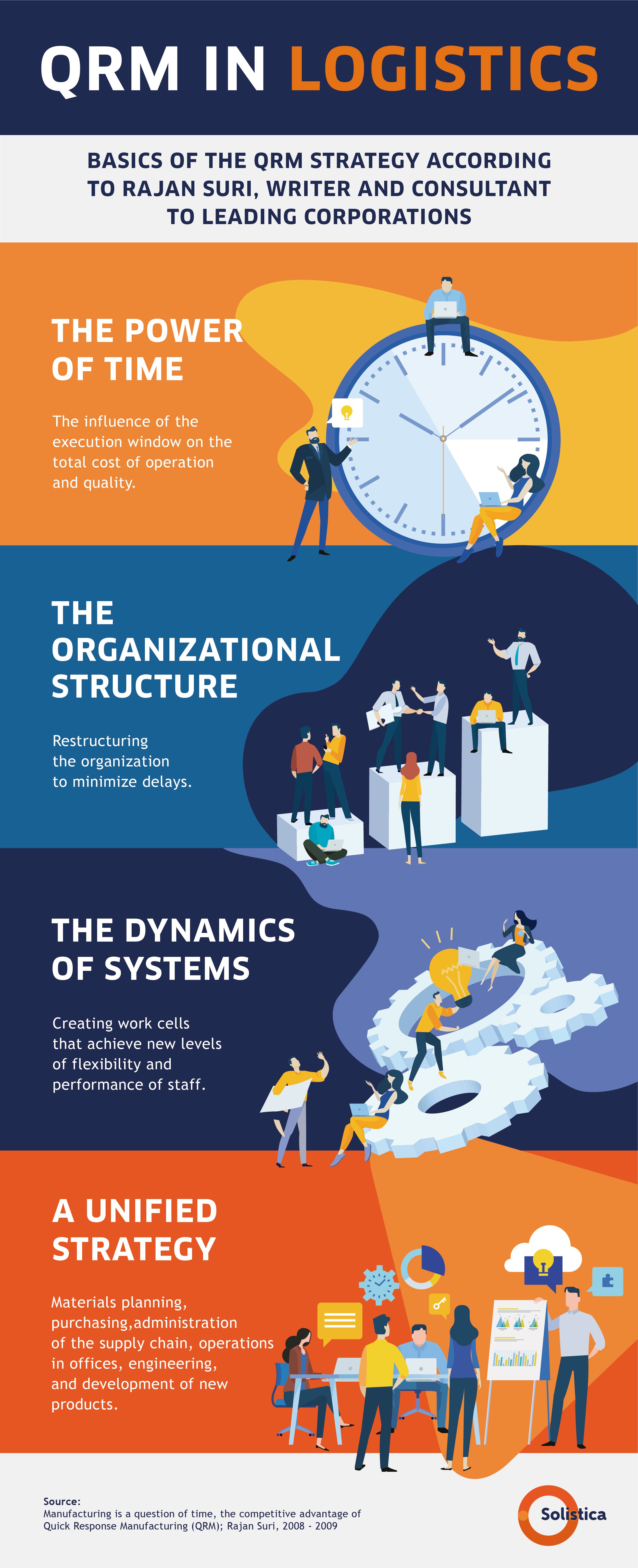The 70’s Just-In-Time philosophy gave birth to diverse models that aim to optimize processes. One of the newest and most effective is Quick Response Manufacturing (QRM).
QRM is an optimization methodology based on logistics that looks to reduce manufacturing’s critical-path time by eliminating downtime in the operation of both the production and administration departments. It targets industries for which product customization is common.
Even though Rajan Suri, professor at the University of Wisconsin-Madison, was the first to mention this method in 1981, it was until 1193 that the Center for Quick Response Manufacturing was founded.
The main goal of this method is to decrease the time of internal and external operations and to give quick response to the needs of customers with customized design and manufacturing.
Just like Lean Manufacturing and the Theory of Restrictions (TOC), it focuses on saving time and lowering hidden costs. Today, more than ever before, companies are looking to save on their supply chains, and this savings do not come only from better negotiations with suppliers, but also from optimizing processes.
When a company implements QRM, it does so across the whole company. Departments like procurement, shipping, finance, and human resources must also apply the techniques, analytical tools, and methodologies to ensure lowering delivery times, since these are not determined only by manufacturing processes.
Companies which regularly implement QRM are those who manufacture advanced-engineering products in small lots, and those who have a vast number of SKUs with fluctuating demand. After implementing the QRM, these companies obtain great benefits:
- Lowering delivery times by 95%
- Lowering the cost of finished product by 30%
- Increasing shipping performance by 60%
- Lowering waste and rework up to 80%
- Better customer service
- Better financial rating
According to Rajan Suri, a QRM strategy is based on four concepts:
- The power of time: the influence of the execution window on the total cost of operation and quality. Traditional manufacturing systems have a negative impact on delivery times and create many costs for planning, foreseeing, and storing. For QRM, execution windows have a priority over productivity and cost.
- The organizational structure: restructuring the organization to minimize delays. Work cells are created to achieve new levels of flexibility and performance of staff.
- The dynamics of systems: creating work cells that achieve new levels of flexibility and performance of staff. Impact of the interactions among machines, people, products, policies for lots, and other decisions affecting delivery times. Processes and actors are streamlined, and capacity controls are created to keep queues small.
- A unified strategy: QRM is designed under a logistics point of view and applies for all levels of the organization: materials planning, purchasing, administration of operations in offices (orders processes and forecasting), engineering, and development of new products.
This model focuses on the Manufacturing Critical-Path Time (MCT); in other words, the time it takes for an order to be fulfilled, since the moment customers place their orders, to the moment they get them after going through a critical path.
Just like the Total Productive Maintenance (TPM) method, QRM is based on creating multidisciplinary teams or cells formed by salespeople, engineers, and manufacturing personnel, among others. Each cell is responsible for a group of products through the whole process: from sale to delivery. When keeping a specific team throughout a whole process is not an option, we must focus only on the most critical stage, which usually presents the most queues, stock, and delays.
Features of the QRM Model
- It focuses on controlling and minimizing queues and inventories in a dynamic way, lowering the number of bottlenecks immediately, even if they change place.
- It is based on environments with customized products and vast catalogs of products and options.
- Does not work with inventories and uses flow regulators called Paired-Cell Overlapping Loops of Cards with Authorization (POLCA), which ensures the speed of orders in the plant without human intervention by using cards that send messages indicating their ability to receive and process semi-finished products. POLCA forbids the manufacturing of products if the queue is exceeded.
- Improves the difunctional variability caused by errors, inefficient systems, and bad organization; for example, rework, changes in priorities, and irregular demand.
- Improves the strategic variability; in other words, everything that keeps a company competitive, for example, the ability to face unexpected changes in the demand, offer more options to customers, and propose customizations.
Elastic Logistics
One of logistics’ greater challenges is to lower stocks as much as possible and show flexibility when facing the unpredictability of interruptions in the supply chain. Prior models are no longer useful for this new environment because they focus only on meeting requisites such as control of expenditures, warehouse management, geographical restrictions, distribution channels, and priority deliveries, instead of focusing on improving the level of customer satisfaction.
Methodologies like QRM and Demand Driven Material Requirements Planning (DDMRP) will be the only ones with the ability to adapt to new logistics processes because they provide the necessary elasticity and flexibility to provide the best customer experience. Furthermore, these models will be the ones better matching the emerging technologies (Internet of Things, Artificial Intelligence, Machine Learning, and Robotics) thanks to their agile approach that considers changes in the demand and behavior of clients.
More than just lower delivery times, QRM means also lower costs thanks to keeping lower stocks, making fewer mistakes, and fewer unfulfilled orders for specific products.
Implementing QRM requires involving the whole organization – including the logistics department – in the process, as well as the manufacturing systems, especially those that affect delivery deadlines.
The efficiency of this model allows greater visibility of the clients’ needs, which results in a higher rate of on-time deliveries and, thus, in an improved customer satisfaction.






